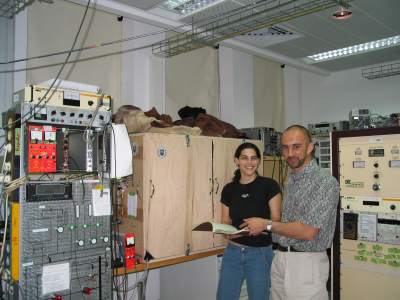Research Topics
Detector Developments (Optical Readout – TPC)
We are collaborating with the Radiation Detection Lab at the Weizmann Institute of Science in Israel, and the Detector Development Group at PTB in Germany, on developing an Optical Readout Time Projection Chamber (O-TPC) to be used in an experiment at the HIγS facility at the TUNL Lab at Duke University for a study of oxygen formation during Stellar Helium Burning (the 12C(a,g) Reaction)– the central problem in Stellar Evolution Theory. During Helium burning the carbon and oxygen elements are produced and the C/O ratio determines the outcome of the core collapse Type II supernova explosion. Oxygen rich star collapses to a black hole and carbon rich star yields a neutron star. The C/O ratio is one of the most fundamental parameter in Stellar Evolution Theory, but it is still unknown in spite of three decades of research, see discussion in Physics Today (2002, Vol 55, #12, page 26).
Experimental Nuclear Astrophysics
We are involved in a number of stellar evolution studies as well as in the use of stars to explore fundamental physical principles, such as the properties of neutrinos, and the search for physics beyond the Standard Model. In this project, we study nuclear reaction rates which are critical nuclear inputs to the Standard Solar Model and for evaluating the total 8B solar neutrino flux (including all neutrino flavors) measured at the Sadbury Neutrino Observatory (SNO) in Canada, as well as measure the formation of 7Be that yield the 7Be solar neutrino flux and the 7Li formed during “Big Bang” nucleosynthesis.
In these studies, our faculty and students resolve(d) some of the most central problems in Nuclear Astrophysics, as was discussed in the Search and Discovery column of the July 1994 issue of Physics Today : questions about Helium burning in massive stars, and the conditions that prevail prior to a supernova collapse. Our work on the Coulomb dissociation of 8B at the radioactive beam facility at RIKEN, and at the GSI facility in Germany, enabled us to resolve questions of proton burning in the sun, and the production of the (8B) solar neutrinos as discussed in a Search and Discovery article in the November 18, 1994 issue of Science magazine.
Facilities in the USA and Abroad
Our experiments are being conducted by faculty and graduate students at various U.S. facilities in Connecticut such as the tandem accelerators at Yale University , and in other states, such as the TUNL Lab at Duke University. We carried out experiments in Argonne National Laboratory, the Holifield Radioactive Ion Beam Facility at Oak Ridge National Lab and at the Michigan State University National Cyclotron Facility.
Our faculty and students are also engaged in research abroad in Europe and Japan, at the radioactive beam facilities at Louvain-La-Neuve in Belgium, at RIKEN in Saitama, outside Tokyo, and at GSI , the heavy ion accelerator in Darmstadt, Germany.

Professor Weissman and Ms. Ayala Ra’anan Hard at Work at Weizmann, Israel.